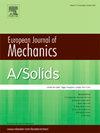Enhancing crashworthiness performance of a battery pack system using multicell square tube structures
IF 4.4
2区 工程技术
Q1 MECHANICS
引用次数: 0
Abstract
This paper focuses on the mechanical reliability and crashworthiness performance of battery pack systems in electric vehicles, evaluating multicell square tube crash wall structures to enhance safety during side pole collisions. We used a nonlinear finite element model to simulate a variety of impact configurations and velocities. The effectiveness of two battery pack layouts was compared: the baseline without a crash wall and the modified layout with a crash wall consisting of five multicell tube structures. The results indicated that the crash wall structures significantly improved performance over the baseline layout. This design reduces the intrusion of the bottom shell by over 45% in the critical impact zone. A hybrid Multi-Criteria Decision Making (MCDM) framework combined Complex Proportional Assessment (COPRAS) and PROMETHEE: Preference Ranking Organization Method for Enrichment of Evaluations effectively utilizes a simulation environment, such as Monte-Carlo simulation to generate a set of ranks to choose the optimum design. Specifically, the corner-to-web (C2W1) structure demonstrated a balanced performance in terms of specific energy absorption, peak load, crushing load efficiency, and minimization of battery pack intrusion. These advancements emphasize the importance of using optimized crash wall structures to enhance battery pack systems’ safety, structural reliability, and integrity.
本文重点研究了电动汽车电池组系统的机械可靠性和耐撞性,评估了多电池方管防撞壁结构,以提高侧杆碰撞时的安全性。我们使用非线性有限元模型模拟了各种碰撞配置和速度。我们比较了两种电池组布局的有效性:无防撞墙的基线布局和由五个多芯方管结构组成的防撞墙改进布局。结果表明,与基线布局相比,防撞墙结构大大提高了性能。这种设计在临界撞击区将底壳的侵入减少了 45% 以上。混合多标准决策(MCDM)框架结合了复杂比例评估(COPRAS)和 PROMETHEE:用于丰富评估的偏好排序组织方法,有效地利用了蒙特卡洛模拟等仿真环境来生成一组排序,以选择最佳设计。具体来说,角到网(C2W1)结构在比能量吸收、峰值负载、压碎负载效率和最小化电池组侵入等方面表现出均衡的性能。这些进步强调了使用优化的防撞墙结构来提高电池组系统安全性、结构可靠性和完整性的重要性。
本文章由计算机程序翻译,如有差异,请以英文原文为准。
求助全文
约1分钟内获得全文
求助全文
来源期刊
CiteScore
7.00
自引率
7.30%
发文量
275
审稿时长
48 days
期刊介绍:
The European Journal of Mechanics endash; A/Solids continues to publish articles in English in all areas of Solid Mechanics from the physical and mathematical basis to materials engineering, technological applications and methods of modern computational mechanics, both pure and applied research.

 求助内容:
求助内容: 应助结果提醒方式:
应助结果提醒方式:


